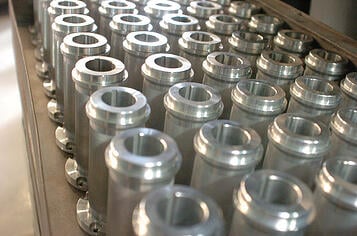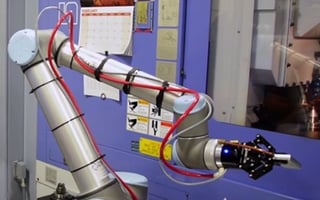Increasing CNC Productivity: More Machines, Outsourcing, or Robots?

Posted on Jun 09, 2016 7:00 AM. 4 min read time
In a business, if we do everything right and the market is on our side, we eventually get to the beautiful problem of too much to do, too few resources to do it. In a factory, this means we need to produce more. How can we increase capacity? Let's explore the pros and cons of 3 options: adding machines, outsourcing, or introducing robots.
Adding Machines
 When all CNCs run at capacity, the obvious option to increase productivity is to add more machines to the shop floor. It would make sense: add a machine, add more processing or parts. Adding a new machine can also open more possibilities in what can be produced, from material to part size and complexity. So on that side it would be a win.
When all CNCs run at capacity, the obvious option to increase productivity is to add more machines to the shop floor. It would make sense: add a machine, add more processing or parts. Adding a new machine can also open more possibilities in what can be produced, from material to part size and complexity. So on that side it would be a win.
On the other side, CNCs cost a lot of money. While this can be amortized over the expected life of the machine so your profit and loss (P/L) is not tanked, it will put serious dent in your cash flow, and possibly require you to get a loan to pay for the machine. In the end, your cost to produce parts will at best remain the same, since you have one more piece of equipment that's costing you money.
Our recommendation: Add a new machine if you need the new features or if you have machines that are nearing their end of life.
Outsourcing
If you can't afford to spend a big chunk of money on a new CNC, a possible option is getting the work done by a subcontractor, and then reselling the part. This can make sense when the part is then reassembled in your shop into a bigger product that you sell. Outsourcing has the advantage of giving you flexibility: you can evaluate different suppliers, increase and decrease volumes as demand evolves, and switch suppliers if the first one is not doing the job.
On the other side, outsourcing will usually be either more expensive or lower quality than if you produced in-house. Subcontractors do need to make their margins too, and they will do that by increasing prices or cutting costs. Outsourcing also requires more involved quality control processes when the parts are delivered, along with managing the supplier in terms of orders, deliveries, contracts, and payments.
Our recommendation: Go with outsourcing if your part is very simple to make and easy to check for defects, or if it's too far outside your expertise.
Introducing Robots
 The third option implies more changes to how you make your products, but it would allow you to get more value out of the same machine. Automating machine loading and unloading will free up your worker for new tasks and allow your CNC to run unattended for long periods of time. With a robot and gripper, you can simply bring a tray of unprocessed parts to the robot, and the robot will feed the part to the CNC on its own, ending with a full tray of processed or finished parts. Machine tending robots can run unattended, thus allowing you to produce during a second shift without having to open a night shift for the workers. This will drop the cost to produce each part and increase productivity without adding headcount or a new machine. Collaborative robot setups suchs as the one Whippany is using in their shop will cost a fraction of the cost of a CNC, so are more gentle on your cash flow while increasing value created by that machine. Also, since the worker is no longer required to feed the CNC by hand, he/she can be assigned to new tasks, or oversee several machines at once.
The third option implies more changes to how you make your products, but it would allow you to get more value out of the same machine. Automating machine loading and unloading will free up your worker for new tasks and allow your CNC to run unattended for long periods of time. With a robot and gripper, you can simply bring a tray of unprocessed parts to the robot, and the robot will feed the part to the CNC on its own, ending with a full tray of processed or finished parts. Machine tending robots can run unattended, thus allowing you to produce during a second shift without having to open a night shift for the workers. This will drop the cost to produce each part and increase productivity without adding headcount or a new machine. Collaborative robot setups suchs as the one Whippany is using in their shop will cost a fraction of the cost of a CNC, so are more gentle on your cash flow while increasing value created by that machine. Also, since the worker is no longer required to feed the CNC by hand, he/she can be assigned to new tasks, or oversee several machines at once.
On the other hand, adding a collaborative robot in your shop will change how you produce and you should work with a trusted partner. The first robot project will require that you manage expectations from the workforce, management and the engineering team, so make sure the project involves all the stakeholders from the start. We have a helpful guide to get you going with your first robot project right here.
Our recommendation: Go with collaborative robots if you are looking to get more out of your existing machines.
Comparison Overview
Here's an overview of the costs you can expect
| Option | Implementation Cost | Incremental Cost | Recommendation |
| Adding a CNC | About 250,000$ | Labor to tend machine | Best if existing machines are nearing end of life |
| Outsourcing | None | Per part, per contract | Best if cash flow is an issue |
| Adding a robot |
About 50,000$, |
Labor to manage the robot | Best to increase per-machine productivity |








Leave a comment